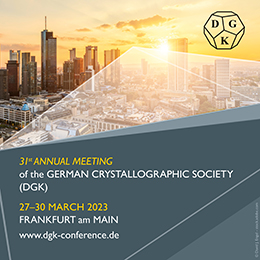


Feature article
Symmetry diagrams for the 17 plane groups now freely available
![thumbnail [thumbnail]](https://www.iucr.org/__data/assets/image/0007/155464/thumbnailnew.jpg)
It is very good news that the IUCr has decided to make the tables of the 17 plane groups (also known as the wallpaper groups) freely available. Seven of the 17 are shown in the Teaching Edition of International Tables for Crystallography (Aroyo, 2021) but the full set has been available only in Volume A of International Tables (Aroyo, 2016). The plane groups are very often used for teaching periodic symmetry because it is much easier to understand relationships in two dimensions than in three. Having the tables available at no cost is an important contribution to the educational mission of the IUCr.
To access the information for the plane groups visit the homepage of Volume A, select plane group from the drop-down menu in the Go to box, and choose the specific plane group from the drop-down menu in the No. box.
Although the identities of the 17 plane groups have been known for over a century (Federov, 1891; Pólya, 1924), they first appeared in International Tables in 1952 (Volume I of the 'Red Series'). Even much later several sets of competing symbols were in use (Schattschneider, 1978). A particular problem was confusion about the labels for p3m1 and p31m (Fig. 1).
![[Figure1]](https://www.iucr.org/__data/assets/image/0009/155457/Fig1.png) Figure 1. Diagrams of the plane groups p3m1 and p31m as they appeared in the 1952 Volume I of International Tables. Triangles indicate threefold rotation points, thicker solid lines indicate mirror lines and dashed lines indicate glide lines. Circles and circles enclosing a comma are enantiomeric.
Figure 1. Diagrams of the plane groups p3m1 and p31m as they appeared in the 1952 Volume I of International Tables. Triangles indicate threefold rotation points, thicker solid lines indicate mirror lines and dashed lines indicate glide lines. Circles and circles enclosing a comma are enantiomeric.
In teaching symmetry, the tables of plane groups are often used in conjunction with C. H. MacGillavry’s (1965) book Symmetry Aspects of M. C. Escher’s Periodic Drawings, in which there are 41 plates of examples. A third edition of the book was published by the IUCr in 2017 (Fig. 2).
![[Figure2]](https://www.iucr.org/__data/assets/image/0010/155458/Fig2.png) Figure 2. Cover of the third edition of the MacGillavry book.
Figure 2. Cover of the third edition of the MacGillavry book.
The history of the MacGillavry book is interesting; much of what follows is taken from Doris Schattschneider’s definitive book (1990) about Escher’s periodic drawings. Both Escher and MacGillavry were Dutch.
Escher knew about crystallographers well before crystallographers knew about Escher. During a visit to his parents in 1937 he showed some of his drawings to his half-brother Berend, a Professor of Geology at the University of Leiden. Berend then sent Escher a list of ten papers (authors F. Haag, G. Pólya, P. Niggli, F. Laves and H. Heesch) published in Zeitschrift für Kristallographie between 1911 and 1933, along with a note suggesting that at least the drawings might be of interest. Escher studied several of the papers very carefully. He transcribed the 1924 article by Pólya, including all its illustrations, into a copybook.
Crystallographers first learned of Escher’s drawings in 1952, when MacGillavry, a Professor of Chemical Crystallography at the University of Amsterdam, saw an exhibit of Escher’s work at the important Museum Boijmans in Rotterdam (now the Museum Boijmans Van Beuningen). MacGillavry returned to the exhibit a few days later, accompanied by all the students and staff of the crystallography laboratory. The first appearance of an Escher drawing in a crystallographic publication is thought to have been in 1955, when Professor Pieter Terpstra of the University of Groningen used the drawing of a horse and rider as the frontispiece of his book Introduction to the Space Groups (Fig. 3). In 1959 Professor J. D. H. Donnay from Johns Hopkins University and Dr Gabrielle Donnay from the Carnegie Institution for Science visited Escher’s studio and asked him to lecture at the 1960 IUCr Congress in Cambridge, England. A few months later MacGillavry visited the studio and encouraged him to accept the invitation. Escher then wrote to his son:
"the nicest thing to have happened to me recently was a visit yesterday afternoon … from a lady, Professor MacGillavry, who … came with her sister-in-law, who was also somehow interested in divisions of the plane, and the two of them had their eyes glued to my prints from half past two till after half past five. What a pair of smart ladies! It’s such a relief to have visitors at last who don’t stare at my creatures uncomprehendingly, but who can chuckle with amusement at anything worth chuckling at."
(quotation taken from p. 103 of Schattschneider, 1990).
![[Figure3]](https://www.iucr.org/__data/assets/image/0011/155459/Fig3.png) Figure 3. Frontispiece and title page of Terpstra’s 1955 book. The text above the drawing is part of a Frisian children’s song; the figure caption gives some information about Escher.
Figure 3. Frontispiece and title page of Terpstra’s 1955 book. The text above the drawing is part of a Frisian children’s song; the figure caption gives some information about Escher.
The talk at the 1960 Congress was a great success. Both the large main hall and an overflow room linked by closed-circuit television were filled, and Escher’s talk was received very enthusiastically. An accompanying exhibit of Escher’s work had been arranged, and many crystallographers bought prints. Some years later, when Escher’s work had become widely popular, some of those owners found their home-insurance premiums had suddenly increased.
Escher’s report of his experience at the 1960 Congress is part of the website of the museum Escher in Het Paleis, which is located in The Hague. At the end of the webpage there is a picture showing Escher and MacGillavry standing together. In the background are several bricklaying patterns, in which the Amsterdam school was interested and used for teaching.
After the 1960 Congress the IUCr commissioned MacGillavry to work with Escher on a book illustrating the plane groups. The book appeared in 1965. Included are 13 drawings that have classical symmetry, 22 that have black/white symmetry (i.e. antisymmetry) and six that have polychromatic symmetry. At MacGillavry’s request, Escher created two new drawings for the book and improved five others; five more drawings in the book were created after Escher participated in the 1960 Congress. Escher graciously granted the IUCr permission 'to permit reproduction of any of the drawings included in the book when such reproduction is requested for teaching or scientific purposes' (Fig. 4).
![[Figure4]](https://www.iucr.org/__data/assets/image/0003/155460/Fig4.png) Figure 4. M. C. Escher’s letter of 15 December 1966 to the IUCr about how his drawings in the MacGillavry book may be used.
Figure 4. M. C. Escher’s letter of 15 December 1966 to the IUCr about how his drawings in the MacGillavry book may be used.
At the 1975 IUCr Congress in Amsterdam a new set of three prints of Escher’s periodic drawings (Plate 13 of the 1965 book and two others) were sold. During the Opening Ceremony, MacGillavry gave the Congress Discourse, which was titled Order and Beauty. I was very happy to be able to meet her during one of the poster sessions and to tell her that it was her book that had led me to the field of crystallography.
Notes on C. H. MacGillavry’s nameMacGillavry was a Professor and the Head of the Crystallographic Laboratory at the University of Amsterdam. In the 1993 obituary by Aafje Looijenga-Vos that was published in the Proceedings of the Royal Netherlands Academy of Arts and Sciences (KNAW), the name is given as Carolina Henriëtte Mac Gillavry. That version is probably authoritative although the version used professionally was C. H. MacGillavry. Vos, two decades younger than MacGillavry and also Dutch, was a crystallographer, a professor at the University of Groningen and very active in the IUCr. MacGillavry’s first given name can be found as Carolina, Caroline and Carolien; all three versions occur in IUCr publications. The first spelling is perhaps the most correct but many people who knew her professionally used the second. The third spelling is Dutch. The second given name, if written, usually appears without the diacritical mark. The family name, Mac Gillavry, is written as MacGillavry in all but a few of her scientific publications, but her father (Donald Mac Gillavry, a brain surgeon) seems to have always included the space. A web search shows that the separating space is still in common use. In the family she was called Lien. Her doctoral students called her Mac. There was indeed a Scottish ancestor: William Mac Gillavry, 1751 (Elgin, Scotland)–1810 (the Netherlands). He was Carolina’s great-great grandfather. A MacGillavry clan website says that William fought in 1794 in the Highland Regiment under Major General Dundas with the allied troops against the French revolutionary army. After being wounded he was taken to the town of Zwolle, where he recovered, supported himself as a teacher of English, married and founded the Dutch branch of the Mac Gillavry clan. |
All the drawings in the MacGillavry book that have classical symmetry are built from at least two different units (e.g. a bird and a fish) so that the boundaries between them can be seen easily. In the drawings built from a single unit, adjacent units are distinguished by color. If there are two colors then the symmetries of the drawing can be analyzed in three ways, i.e. by considering the two colors as different, the same or opposites (Fig. 5).
![[Figure5]](https://www.iucr.org/__data/assets/image/0004/155461/Fig5.png) Figure 5. Plate 25 of MacGillavry’s book marked to show the symmetry of the conventional unit cell (darker lizards not equivalent to lighter lizards; group p4) and the antisymmetry (or magnetic) unit cell (symbol p’c4, p’4 or pp4; group 10.4.52 in Litvin’s 2013 compilation). For the smaller magnetic cell, the classical symmetry elements are black and the antisymmetry elements are red.
Figure 5. Plate 25 of MacGillavry’s book marked to show the symmetry of the conventional unit cell (darker lizards not equivalent to lighter lizards; group p4) and the antisymmetry (or magnetic) unit cell (symbol p’c4, p’4 or pp4; group 10.4.52 in Litvin’s 2013 compilation). For the smaller magnetic cell, the classical symmetry elements are black and the antisymmetry elements are red.
If the two colors are considered antisymmetric, i.e. are related by an operation of antisymmetry that changes the colors (e.g. black to white) or the direction of the magnetic moment (parallel or anti-parallel to a given direction), there are 46 possible plane groups. The combination of the antisymmetry operation with the ordinary plane-group operations results in the compound antisymmetry operations, i.e. a successive performance of ordinary plane-group operation and the operation of antisymmetry, cf. Figs. 5 and 7. Allowing combined antisymmetry operations makes it possible to derive the 80 antisymmetry plane groups, which include the 46 black-and-white or magnetic plane groups, the 17 'white' plane groups (i.e. no antisymmetry operations) and the 17 'grey' plane groups. The grey groups contain an additional anti-symmetry version of every symmetry operation and so superimpose differently colored (e.g. black and white) units.
Diagrams of these groups are available in Danny Litvin’s extensive (>12,000 pages) compendium of magnetic space groups that was published by the IUCr in 2013 as an open-access e-book (Fig. 6) and that built on the work of Shubnikov, Belov et al. (1964). The tables for the plane groups can be found by searching Part 2. Tables of Magnetic Groups (98 MB) for Index of Two-Dimensional Magnetic Space Groups (p. 2279 in the current edition). The tables for the 80 groups fill the following 161 pages.
![[Figure6]](https://www.iucr.org/__data/assets/image/0006/155463/Fig6.png) Figure 6. Cover of the Litvin e-book.
Figure 6. Cover of the Litvin e-book.
The diagrams for the group of an Escher drawing with antisymmetry are shown in Fig. 7. The classical symmetry elements are black whereas the antisymmetry elements are red. The arrows in the group diagram represent the magnetic moments. Classical rotations affect magnetic moments and position vectors in the same way but classical inversion has no effect on the magnetic moment. A mirror line that changes x,y to x,y then changes the magnetic moment from u,v to u,v.
![[Figure7]](https://www.iucr.org/__data/assets/image/0008/155465/Fig7.png) Figure 7. Part of Plate 19 of the MacGillavry book along with the diagram for its antisymmetry group (cp1m1, no. 5.4.22 in Litvin’s 2013 compilation; in other systems the symbols are p’cm, p’c1m and cpm). The generated lattice vectors, given in the upper-left corner of the symmetry-element diagram, are color coded; the red is coupled with the antisymmetry operation whereas the black are not.
Figure 7. Part of Plate 19 of the MacGillavry book along with the diagram for its antisymmetry group (cp1m1, no. 5.4.22 in Litvin’s 2013 compilation; in other systems the symbols are p’cm, p’c1m and cpm). The generated lattice vectors, given in the upper-left corner of the symmetry-element diagram, are color coded; the red is coupled with the antisymmetry operation whereas the black are not.
The symbols for the magnetic groups have not yet been standardized but progress is being made in that direction (Campbell et al., 2022). The last page of the third edition of MacGillavry’s book provides the symbols for the antisymmetry groups for Plates 14–35 in five different systems; Litvin’s symbol is accompanied by his group number.
Escher had no formal training in higher mathematics but did correspond with several prominent mathematicians (e.g. Pólya, Coxeter, Penrose) and published two books [e.g. Grafiek en tekeningen in 1959; see pp. 337ff in Schattschneider (1990) for a complete list of writings by and about Escher]. He also explored polychromatic symmetry, a topic that mathematicians have not yet finished analyzing (see Senechal, 1988). Schattschneider’s (1990) book contains extensive reproductions of pages from Escher’s notebooks as her stated goal was to answer the question: How did he do it? Studying her book provides insight into Escher’s creative process.
Other sets of drawings with 2D periodicity were inspired by Escher’s work, two of which have strong connections to crystallography. On the occasion of the 1981 IUCr Congress in Ottawa, François Brisse (1981) created a set of 17 drawings based on Canadian themes. In Arthur L. Loeb’s book Color and Symmetry (1971) there are 86 geometrical 2D patterns that illustrate color groups. Loeb, a senior lecturer at Harvard in the Visual and Environmental Studies Department, earned a PhD in chemical physics at that university after having left Holland as a teenager at the beginning of WWII. Later he came to know Escher well.
The efforts of all of these people have provided a wealth of material for teaching periodic symmetry, solving intriguing puzzles and pondering the more complicated problems of polychromatic symmetry. Having the IUCr’s plane group diagrams freely available is an important step towards making this material easier to understand. The complete information about plane groups does not seem to be available anywhere else.
Acknowledgements
I am very grateful to Doris Schattschneider, who made many comments on the first draft of this article. Danny Litvin, Mois Aroyo, Ton Spek and Marjorie Senechal were also very helpful. This also seems a good place to thank Henk Schenk and Peter Strickland for putting together the third edition of the MacGillavry book, which was not a small project.
References
Aroyo, M. I. (2016). Editor. International Tables for Crystallography, Vol. A, Space-group symmetry. Chester: International Union of Crystallography.
Aroyo, M. I. (2021). Editor. International Tables for Crystallography, Teaching Edition Crystallographic Symmetry. Chester: International Union of Crystallography.
Brisse, F. (1981). Canad. Mineral. 19, 217–224.
Federov, E. (1891). Proc. Russ. Mineral. Soc. 28, 345–390.
Loeb, A. L. (1971). Color and Symmetry, edited by M. J. Buerger. London: Wiley.
MacGillavry, C. H. (1965). Symmetry Aspects of M. C. Escher's Periodic Drawings. Utrecht: A. Oosthoek's Uitgeversmaatschappij NV for the International Union of Crystallography.
Pólya, G. (1924). Z. Kristallogr. 60, 278–282.
Schattschneider, D. (1978). Am. Math. Mon. 85, 439–450.
Schattschneider, D. (1990). Visions of Symmetry; Notebooks, Periodic Drawings, and Related Work of M. C. Escher. New York: W. H. Freeman and Company. [2nd ed. (2004) titled M. C. Escher: Visions of Symmetry. New York: Abrams]
Senechal, M. (1988). Comput. Math. Appl. 16, 545–553.
Shubnikov, A. V., Belov, N. V. et al. (1964). Coloured Symmetry. Edited by W. T. Holser. Translated from Russian by J. Itzkoff and J. Gollob. Oxford: Pergamon Press.
Copyright © - All Rights Reserved - International Union of Crystallography









